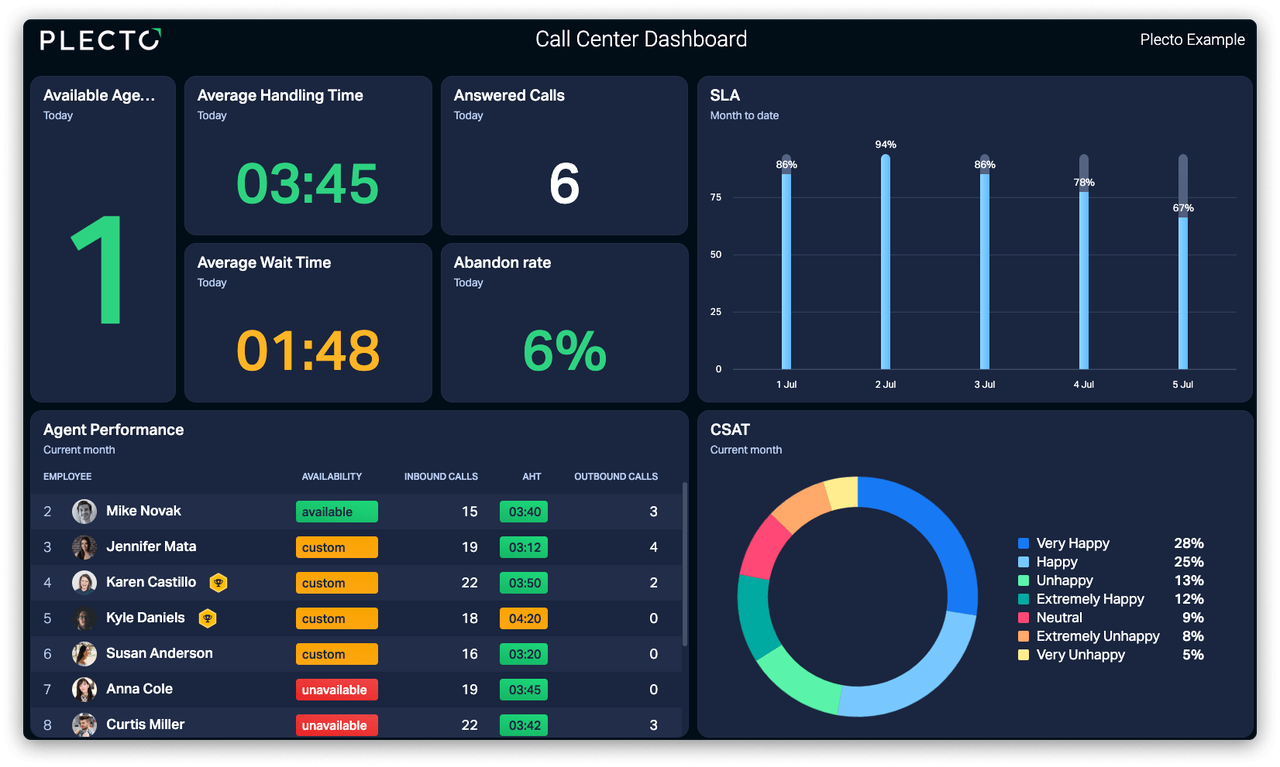With rising costs and increasing competition, virtually all industries are facing tough choices as customers’ expectations for prices and service quality continue to rise. Although some companies choose to compete on price, they often find that being one of the cheapest options while cutting corners on service proves to be short-sighted.
Providing better service and support than your competitors can build customer loyalty, improve retention, and drive growth. Salesforce research reveals that excellent customer service would secure the loyalty of 75 percent of customers – even after committing a faux pas. The same research found that good customer service increases the likelihood of repeat purchases for 88 percent of customers while 75 percent say they’ve recommended a company after receiving excellent customer service.
When a company decides to compete on service standards, its call center takes center stage – and it’s a notoriously busy, high-stress environment that needs strong leaders who can motivate, encourage, and retain their reps.
Read on to discover eight tips for effective call center management in today’s high-stakes environment.
What is call center management?
Call center management is the heart of world-class service and support. It’s responsible for the day-to-day handling or delegation of hiring, onboarding, scheduling, and coaching employees; developing and implementing new tools and processes; internal communication, quality assurance, customer experience – and more!
Without effective managers who can stay calm under pressure while motivating their teams through their most arduous shifts, call center employees are likely to burn out and eventually quit. In fact, the employee turnover rate in customer service is 1.3 times the average turnover in other departments.
The 3 Key Call Center Roles
A well-functioning call center requires a high degree of teamwork between employees at every level of the hierarchy. Each of these three key roles plays an integral role in providing top-quality service:
1. Call Center Manager
This is the head honcho responsible for overseeing all aspects of call center management, including budgets. At the highest level, the call center manager sets and tracks the department’s KPIs, gathers and analyzes customer feedback, and drives the customer service strategy. On a more practical level, they’re responsible for overseeing the recruiting, onboarding, and management of call center staff. The buck generally stops here as the call center manager is responsible for resolving any issues that couldn’t be resolved further down the chain of command, requiring escalation to the highest level.
2. Call Center Supervisor
Sometimes known as the “team lead,” this is an operational role with the day-to-day responsibility for ensuring the team’s productivity and success. This includes things like scheduling and absence coverage, conflict resolution, supporting and coaching agents, giving performance evaluations, and making sure that all customer interactions meet the company’s standards. Supervisors usually have extensive knowledge of their company’s offerings and policies – and they’re the first port of call when an issue is escalated. In some organizations, this role overlaps with the call center manager when it comes to people management.
3. Call Center Agent/Rep
These are the people in the hotseat. They’re on the frontline interacting directly with customers to resolve their inquiries, and it’s a notoriously difficult role. Call center reps are the face of the company and must always remain polite and professional while providing accurate information and ensuring that every customer feels heard and valued – regardless of their behavior. It’s the agents’ job to know the company’s offerings and policies, to communicate clearly and according to guidelines, to identify and escalate inquiries beyond their authority, and follow the company’s procedures for post-call documentation.
8 Tips for Effective Call Center Management
With their stressful environments, high turnover, and unpredictability, managing a call center can seem like a Herculean task – but it doesn’t have to be. These eight tips will help you tune out the noise and focus your attention where it’s likely to yield the most pronounced results in terms of employee satisfaction, performance, and retention.
1. Invest in training and coaching
Many staffing issues could be avoided if companies would invest in a comprehensive training program for new hires, and ongoing coaching and training for veteran agents. To empower new employees to do their best job, take the time to explain what “excellent service” looks like in your call center, how to provide it, and how it’s measured. Once an employee has been onboarded, regular 1:1 coaching sessions can boost loyalty and retention by providing personalized opportunities for employees to develop their skills, take on more responsibility, and assume more challenging tasks. People who feel appreciated and supported are likely to thrive and stay in their jobs longer than those who don’t – and the longer people stay in their jobs, the more confident and competent they become.
2. Visualize a mission statement and shared KPIs
When people understand what’s expected of them, it’s easier to deliver. Formalizing this with a mission statement summarizing the team’s overall objective combined with clear KPIs can help new hires quickly find a sense of belonging while incentivizing everyone to work together to reach their goals. Visualizing KPIs on dashboards around the office can boost motivation by enabling the team to track their progress – and celebrate their success whenever they reach a milestone!

3. Incentivize performance
According to research by Gallup, 65 percent of employees say that they haven’t received any recognition at work within the past year – and 78% say they’d work harder if they received more recognition. Managers in high-turnover environments like call centers can’t afford to ignore these statistics. Whether it’s an individual spot reward for going above and beyond or a more metered approach of using leaderboards, instant notifications, and challenges to recognize everyone’s small wins, incentivizing performance is proven to increase and sustain motivation.
4. Use gamification
While gamification can be a performance-incentivizing tactic, it deserves its own mention for the extent to which it can help to motivate and retain employees by adding an element of fun to the tedium of their workday. According to research, 72 percent of employees say that gamification increases their motivation and makes them work harder while 69 percent say they’d stay with an employer for longer than three years if gamification were part of their daily operations. Whether your main concern is motivating call center employees or retaining them, there’s a strong case for using gamification!
Build your first dashboard.
Start your 14-day free trial today
5. Invest in the right software
Call center management has myriad software options for integrating telephony systems with other mission-critical systems. The right integrations can streamline processes, enabling your team to provide informed, personalized service with greater efficiency. Likewise, investing in tools to make your rep’s jobs easier signals that you care about their success; not to mention improving service quality – and hopefully, customer satisfaction.
6. Cross-train reps on different channels
As omnichannel support gains traction, it’s not a foregone conclusion that call center work means spending an entire shift with a headset glued to one’s ear. Cross-training your agents across different channels can give them some variety in otherwise tedious tasks. This can also be used as an incentive where top-performing reps can be “certified” to work on more channels. Adding variety is a smart way to counteract boredom without sacrificing productivity while creating an agile team that can pivot on demand to handle fluctuating volumes across channels.
7. If you can’t offer flexibility, offer perks
The COVID era proved that many jobs can be done from home, and a lot of people want to keep that freedom. Although mandatory on-site attendance can be a disadvantage compared to remote or hybrid options, offering perks like gaming and exercise equipment, snacks, soft drinks, and on-site services can help take the sting out of coming to the office. To boost morale, consider providing a surprise lunch or other treats during particularly stressful and busy times (or even “just because”).
8. Track employee satisfaction or employee net promoter score (eNPS)
As a manager, you might think you’re doing everything right, but if your efforts don’t resonate with your team, you’ll continue to face low productivity, absenteeism, and high turnover. To get to the nitty-gritty of how your team feels about coming to work, conduct regular and anonymous mini-pulse surveys or eNPS. eNPS gauges employee satisfaction by asking, “On a scale of 1–10, how likely are you to recommend our company as an employer to a friend?” This is the best way to identify issues and protect the investment you’ve made in your people.
Regardless of which tactics you choose for more effective call center management, visualizing and tracking your KPIs on individual and departmental dashboards will help everyone keep tabs on how they’re performing individually and as part of the team. Plecto makes it easy to create customer service KPI dashboards and share your data with everyone on your team.
And if you’d like to test the waters with gamification, Plecto also provides built-in gamification features as well as leaderboards, instant notifications, points, and badges to keep your team motivated and engaged!




